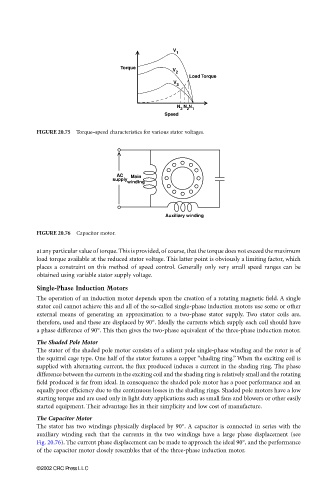Page 576 - The Mechatronics Handbook
P. 576
0066_Frame_C20 Page 46 Wednesday, January 9, 2002 5:49 PM
V
1
Torque
V
2
Load Torque
V
3
N N N
3 2 1
Speed
FIGURE 20.75 Torque–speed characteristics for various stator voltages.
AC Main
supply
winding
Auxiliary winding
FIGURE 20.76 Capacitor motor.
at any particular value of torque. This is provided, of course, that the torque does not exceed the maximum
load torque available at the reduced stator voltage. This latter point is obviously a limiting factor, which
places a constraint on this method of speed control. Generally only very small speed ranges can be
obtained using variable stator supply voltage.
Single-Phase Induction Motors
The operation of an induction motor depends upon the creation of a rotating magnetic field. A single
stator coil cannot achieve this and all of the so-called single-phase induction motors use some or other
external means of generating an approximation to a two-phase stator supply. Two stator coils are,
therefore, used and these are displaced by 90°. Ideally the currents which supply each coil should have
a phase difference of 90°. This then gives the two-phase equivalent of the three-phase induction motor.
The Shaded Pole Motor
The stator of the shaded pole motor consists of a salient pole single-phase winding and the rotor is of
the squirrel cage type. One half of the stator features a copper “shading ring.” When the exciting coil is
supplied with alternating current, the flux produced induces a current in the shading ring. The phase
difference between the currents in the exciting coil and the shading ring is relatively small and the rotating
field produced is far from ideal. In consequence the shaded pole motor has a poor performance and an
equally poor efficiency due to the continuous losses in the shading rings. Shaded pole motors have a low
starting torque and are used only in light duty applications such as small fans and blowers or other easily
started equipment. Their advantage lies in their simplicity and low cost of manufacture.
The Capacitor Motor
The stator has two windings physically displaced by 90°. A capacitor is connected in series with the
auxiliary winding such that the currents in the two windings have a large phase displacement (see
Fig. 20.76). The current phase displacement can be made to approach the ideal 90°, and the performance
of the capacitor motor closely resembles that of the three-phase induction motor.
©2002 CRC Press LLC

